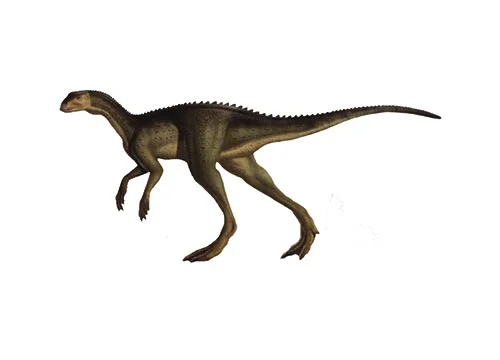Oryctodromeus (Digging Runner)

Oh-rik-toe-dro-mee-us
Varricchio et al. – 2007
Herbivore
Estimated 2 meters long
Euornithopod
O. cubicularis (type)
USA, Idaho – Wayan Formation, Montana – Blackleaf Formation
Late Cretaceous, 95-90 million years ago
Oryctodromeus Facts
Oryctodromeus, which means “digging runner,” is a genus of small burrowing herbivorous dinosaur that lived during the Late Cretaceous period, around 95-90 million years ago. Its fossils were first discovered in Montana, USA, in the early 2000s.
Oryctodromeus was a member of the family Hypsilophodontidae, which were small, bipedal herbivores that lived during the Cretaceous period. It was about 2 meters (6.5 feet) in length and weighed around 45 kilograms (100 pounds).
Oryctodromeus had a stocky build, long legs, and short arms. It had a long, stiff tail, which likely helped it to maintain balance while burrowing. It had a small, narrow skull with large eyes and a pointed snout. Its teeth were leaf-shaped and adapted for cutting and grinding plant material.
Based on its anatomy, Oryctodromeus is thought to have been a fast runner and a good burrower. It likely used its strong legs and tail to dig burrows in the ground, where it could hide from predators or shelter its young. It may have lived in small family groups, with adults helping to care for the young.
Oryctodromeus is an important dinosaur for scientists to study because it provides valuable information about the behavior and ecology of small herbivorous dinosaurs. Its burrowing behavior is unique among known hypsilophodontids, and suggests that these dinosaurs had a greater range of ecological niches than previously thought. The discovery of Oryctodromeus and other burrowing dinosaurs has also led to new insights into the evolution of social behavior in dinosaurs.
In conclusion, Oryctodromeus was a small, burrowing herbivorous dinosaur that lived during the Late Cretaceous period. Its stocky build, long legs, and leaf-shaped teeth are characteristic of the hypsilophodontids, a family of small, bipedal herbivores. Its unique burrowing behavior has provided valuable information about the ecology and behavior of these dinosaurs, and helps us to better understand the diversity of life that existed on Earth millions of years ago.



